Are you an eCommerce store owner with millions of dollars in sales per year? If so, you may want to consider choosing an enterprise-level platform. Two of the most highly appreciated options at the moment are Shopify Plus vs Magento Commerce or Adobe Commerce (formerly Magento Enterprise and Magento Enterprise Cloud).
You may wonder which platform is more powerful, but well, this is just one part of the question. The other part is about which one is better suited to your current business. Via this article, LitExtension – #1 Shopping Cart Migration Expert will compare the key functionality of Shopify Plus vs Magento Commerce to help you make your final decision. Keep reading to get:
- An overview of Shopify Plus vs Magento Commerce
- Detailed comparison of notable features (pricing, flexibility, eCommerce features…)
- Final verdict: Which one is the best suit for your business
Need Help To Migrate Your Store?
LitExtension provides a well-optimized Cart to Cart migration service that will help you transfer all your data accurately, painlessly with utmost security.
Shopify Plus vs Magento Commerce Overview
What is Shopify Plus?
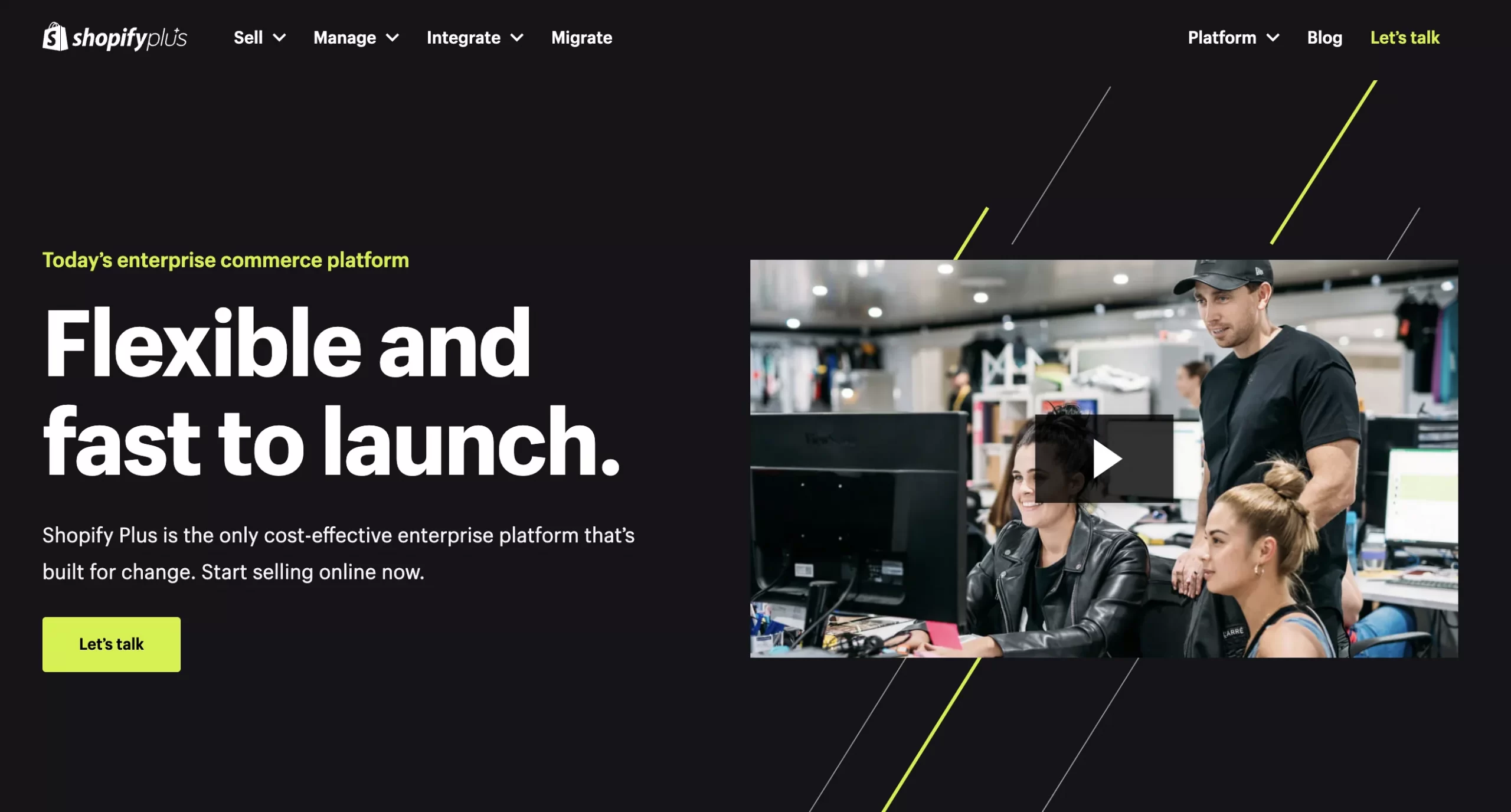
Shopify Plus is the enterprise edition of Shopify, giving access to many more new features, integrations, your store’s underlying code, and dedicated support options than Shopify. However, Shopify Plus features and dashboard are similar to Shopify.
Some of the most well-known Shopify Plus clients are Nestle, Hawkers, Kylie Jenner, Budweiser, PepsiCo, Current Body, Gymshark, and Protein World.
Discover more about Shopify:
What is Magento Commerce?
Magento Commerce is an enterprise platform built for rapid and cost-effective innovation, combining out-of-the-box functionalities, enterprise performance and scale, and powerful business tools to keep you ahead of increasingly complex eCommerce.
This eCommerce platform is better known as an open-source eCommerce platform, but actually, it has been offering a free version – Magento 2 Open-Source and a paid version – Magento Commerce since its inception.

With the release of their Magento 2.0 version in 2015, these versions were re-branded as Magento 2 Open-Source (previously Community) and Magento Commerce, now Adobe Commerce (previously Enterprise & Magento Commerce Cloud). Adobe Magento Commerce gives you two options: to self-host or pay for cloud hosting as part of the subscription fee.
Some of the largest Magento Commerce customers are Helly Hansen, Paul Smith, End Clothing, MADE.com, BrewDog, Paperchase, and Bulk Powders.
If you want to know more about the difference between Magento Community vs Magento Enterprise, you should have a look at our comparison.
Discover more about Magento 2 (Adobe Commerce):
Shopify Plus vs Magento Commerce Comparison
Similar to Shopify vs Magento, Shopify Plus vs Magento Commerce are the two best platforms for enterprise brands exclusively for high-volume sales. Both of them are trusted by thousands of merchants all over the world. They are frequently pitted against one another for platform superiority, even though, in reality, they have very little in common.
#1 Pricing
Before considering other factors, you may want to take Shopify Plus vs Magento Commerce pricing into account. Every store owner wants to avoid unnecessary charges to minimize their investment.
Shopify Plus Pricing
With Shopify Plus, you need to click on the Get Pricing button and fill in their contact form to get a quotation. Shopify Plus pricing is not public on the website, and you can negotiate the rates based on your sales volume.
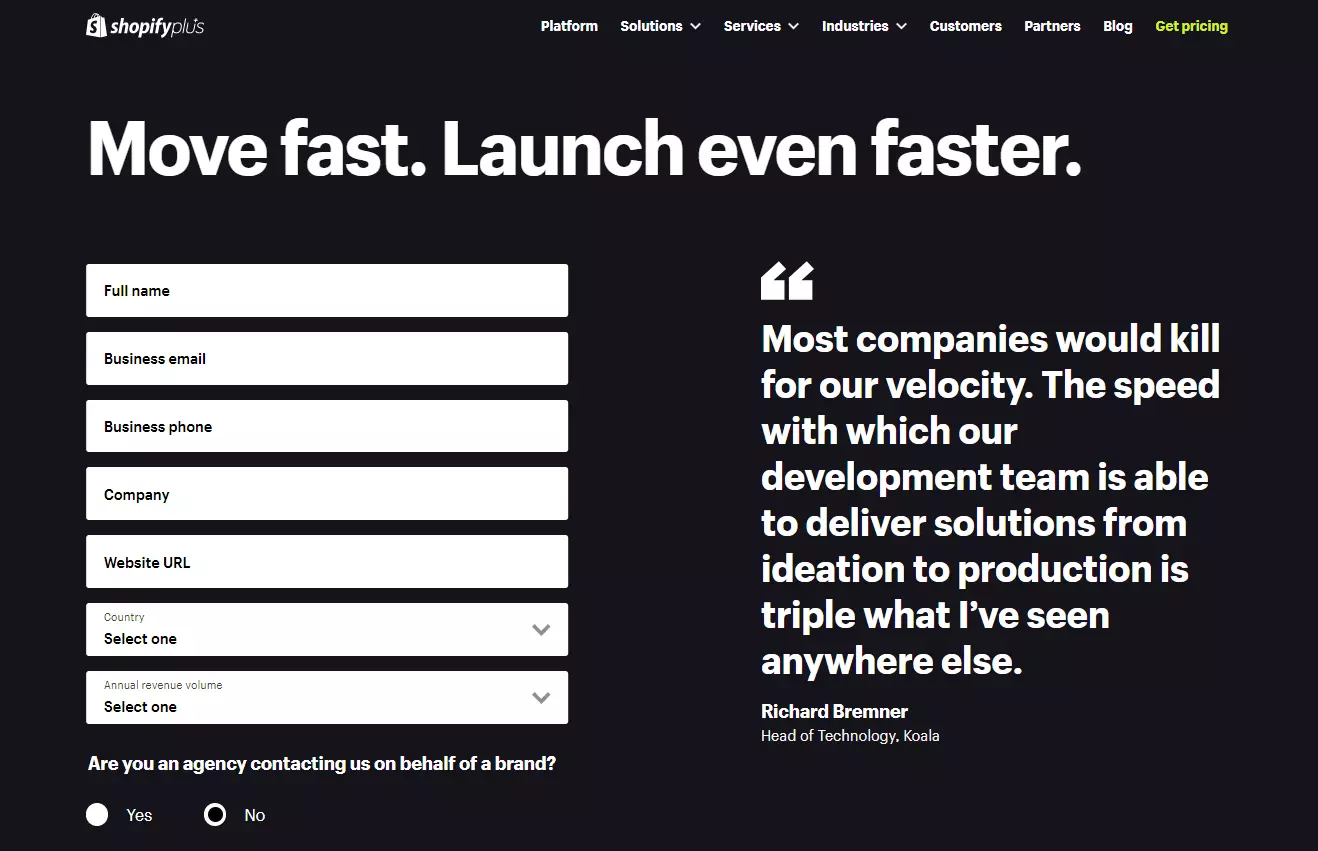
However, you can have a look at the costs that you have to incur below:
- Platform fee: the minimum charge for this is $2,000. However, their charging method will change into a revenue-based model after you score $800,000/month in sales. You will pay 0.25 % of your monthly revenue, but no more than $40,000.
- Hosting: Shopify Plus requires no further cost for hosting service. Migrating your site to Shopify Plus will clear any concerns about hosting, networking, or load testing.
- Development cost: Theoretically, your build cost is from zero to $180 if you use available Shopify themes. However, as a large retailer, you may demand custom features for your store. Depending on the agency hired, your customization cost can differ significantly from $30,000 to $250,000.
In terms of Credit card processing fees, the fee differs depending on what payment method you choose. Shopify offers its own payment provider (Shopify Payments) along with a wide range of supported third-party payment providers.
- For Shopify Payment, you will pay based on the plan you choose. This rate on Shopify Payment can be negotiable if you have a high sales volume and a good merchant history. (“Good merchant history” here means that your business is not in an industry that has had a history of scamming, and the products you sell do not violate regulations and legal requirements.)
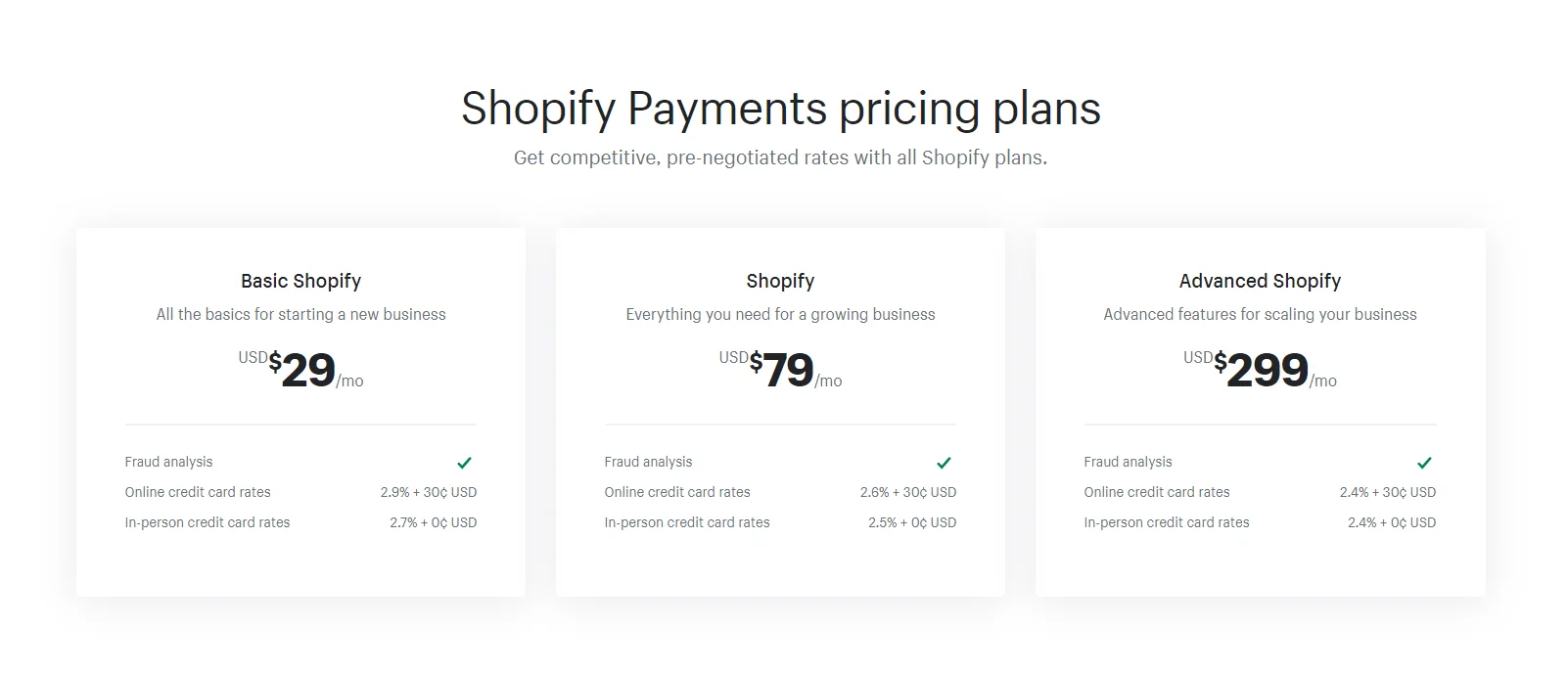
Shopify Payments pricing plan - For AMEX and international cards, you would bear an additional fee of 1%.
- If choosing other payment gateways like PayPal, 2Checkout, and Skrill, you would incur an extra 0.15% fee.
Magento Commerce Pricing
Adobe Magento Commerce pricing is negotiable. You may need to submit your business information to get the exact pricing plan for your eCommerce store.

For Magento 2 Commerce, you can encounter and refer to the following charges:
- Platform fee: Magento’s license fee is an annual up-front fee based on merchants’ Gross Merchandise Value (GMV) and company size. As a result, the pricing for Magento varies widely. Licensing starts at about $22,000 per year.
The table below shows the platform fee of Magento Commerce based on annual revenue:
| Revenue per year (USD) | Magento Commerce (self-host) | Magento Commerce Cloud |
| 0 – <1 M | $22,000 | $40,000 |
| 1 – <5 M | $32,000 | $55,000 |
| 5 – <10 M | $49,000 | $80,000 |
| 10 – <25 M | $75,000 | $120,000 |
| 25 – <50 M | $125,000 | $190,000 |
- Development cost: Average Magento Commerce Edition build cost varies between $100,000 and $500,000, and can also be much higher. It is much more expensive than Shopify Plus.
- Hosting: Unlike Shopify Plus, hosting service is not included in Magento’s platform charge. You may consider selecting third-party hosting services that cost about $1,000/month. Another choice is Magento 2 Commerce Cloud Hosting, about $3,333 per month for both hosting and platform fees combined.
About Magento Commerce hosting fee from a third-party provider, $1,000 is just the minimum recommended rate. Based on your store traffic, you need to choose a reliable hosting company and a suitable package. If the number of site visitors increases unexpectedly and your server is not strong enough, your site will crash down.
Some may be confused about why the development cost of Magento Commerce is much more expensive than Shopify Plus. Although Shopify Plus enables you to customize your store much more than the standard plans, the server-level configuration is still restricted. Even when you want to pay more to modify the site the way you want, you cannot change anything.
The verdict
Magento Commerce would charge higher prices for the services combined than Shopify Plus. However, it would be a favorable option for store owners who need to access source code for further development features.
#2 Extensions & Apps
A majority of the popular third-party systems, like ERPs, fulfillment services, payment gateways, etc., are now available on the app store and marketplace of both Commerce Magento and Shopify Plus.
Shopify Plus Apps

As a SaaS offering, Shopify Plus has thousands of pre-vetted apps available to support merchants at a very low cost. You can access more support with advanced Shopify Plus apps that are exclusive for high-growth merchants:
- Shopify Flow: an eCommerce automation platform that helps you reclaim your time and focus on growing your business. With Flow, it is easy to automate tasks and ideas within your store and across your apps.
- Launchpad: a scheduling tool that is integrated with your Shopify admin, allowing you to schedule product visibility, Shopify Scripts, themes, discounts, and more with a defined start and end time. It is particularly a helpful tool to automate your sales campaigns on Black Friday and Cyber Monday,…
- Script Editor: an exclusive app tailored for Shopify Plus merchants. There are some common types of Shopify Scripts, including line item scripts, shipping scripts, and payment scripts. By using scripts, you can implement custom logic and customize personalized customers’ checkout journeys.
- Transporter: data migration tools that simplify the process of switching to Shopify Plus. However, you need to convert legacy platform data to Shopify-friendly CSV files, which means your data file structure needs to follow Shopify’s standards. If you are not a tech person, it can be a huge obstacle to your migration process. In that case, LitExtension would be the best choice for you to get the job done.
Magento Commerce extensions
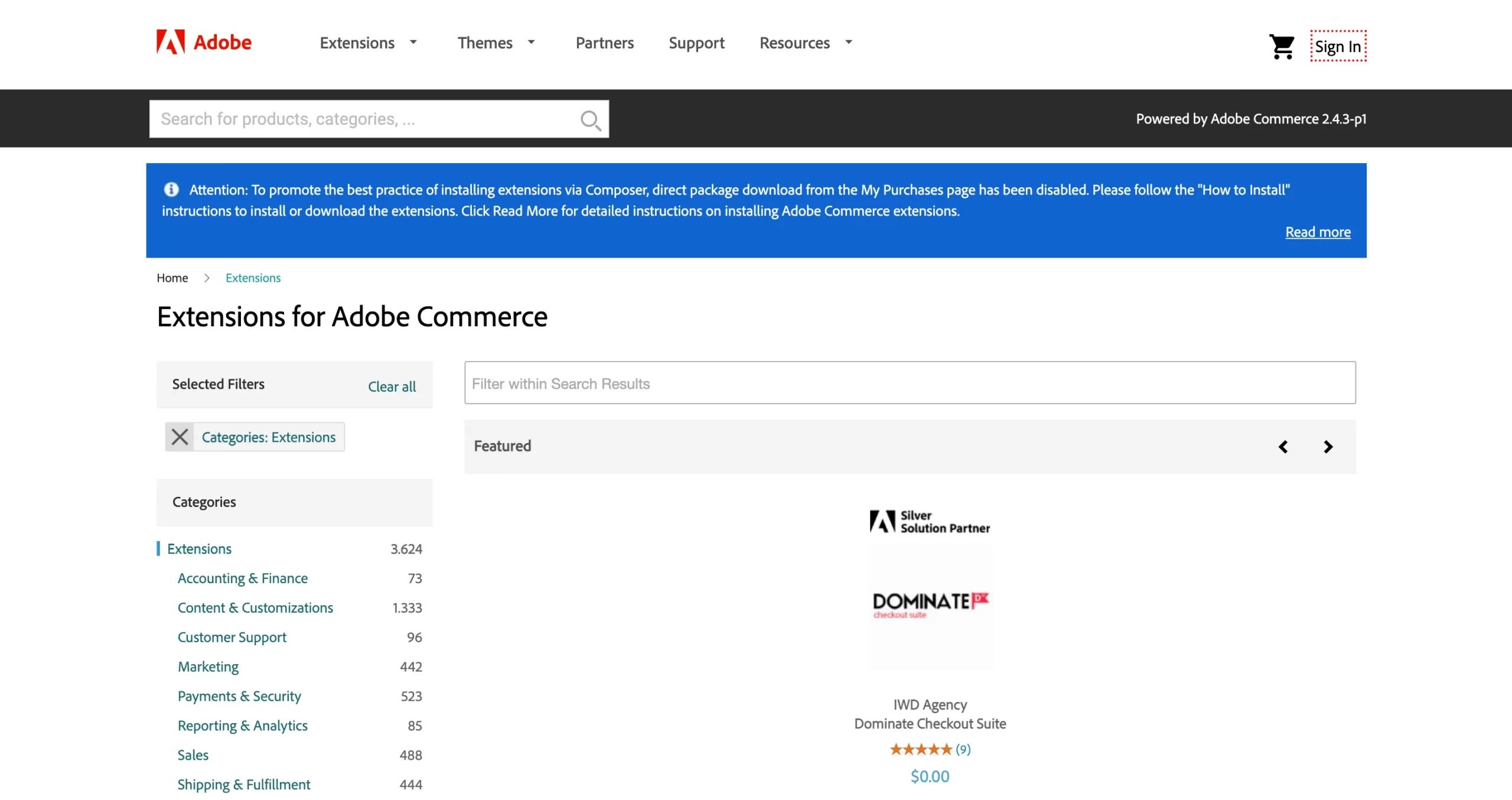
Unlike Shopify Plus, Magento Commerce does not build any exclusive apps for large-scale businesses. However, you still have a wide range of choices between hundreds of third-party extensions on Magento Marketplace that support both self-hosting and cloud-hosting versions.
The verdict:
Although both platforms have well-established ecosystems of existing integrations and extensions, Shopify Plus still offers a broader package for larger-scale clients.
Need Help To Migrate Your Store?
Shopify Migration is super easy with LitExtension. We help you transfer all your data to Shopify accurately and seamlessly with utmost security.
#3 Flexibility & Scalability
Both Shopify Plus vs Magento Commerce are built for enterprise-level businesses operating at scale.
Shopify Plus Flexibility & Scalability
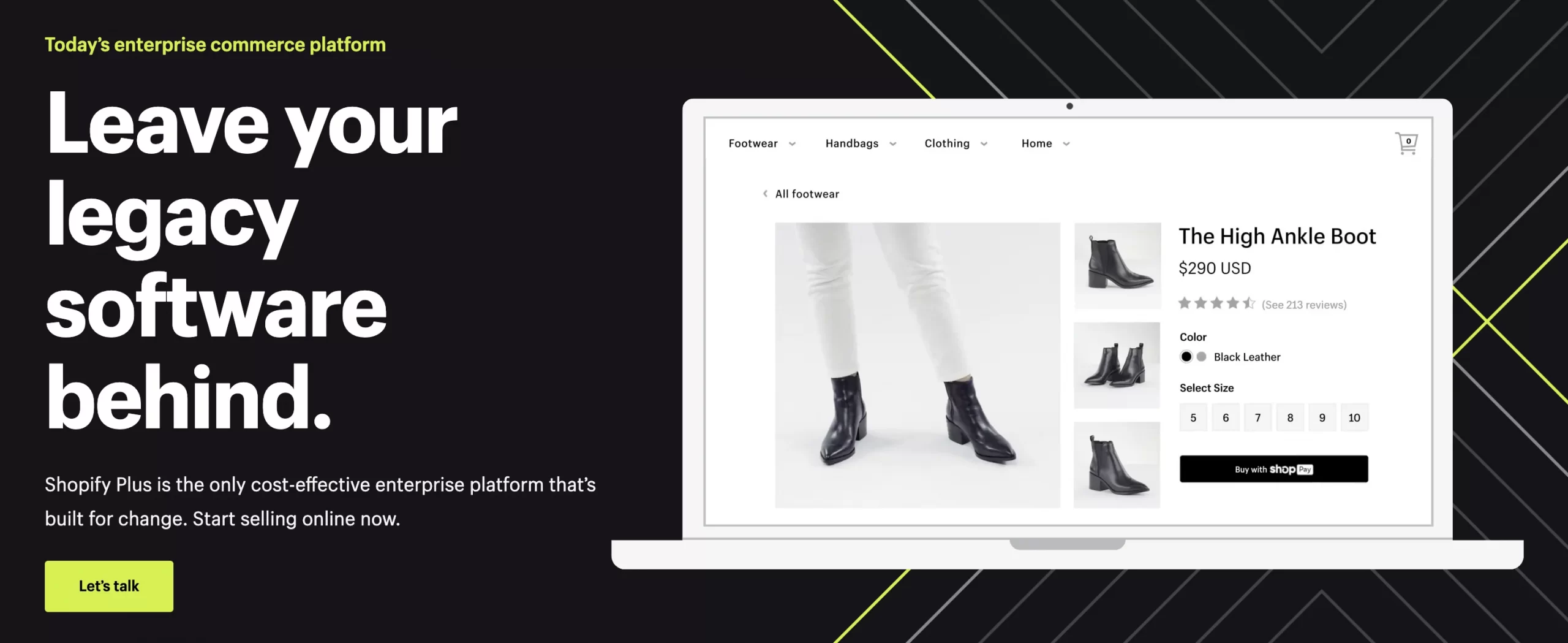
As you expand your business (to a global scale), running your online store will get more and more complex. To minimize any limitation of growing, Shopify Plus supports:
- Shopify Flow for automating merchandising, customer loyalty, and fraud prevention;
- Launchpad for supporting massive flash sales and mitigating bots;
- Selling in multiple currencies within a single store;
- Globally selling in multichannel across 100+ social media channels and 80+ online marketplaces;
- Managing staff access & accounts of the entire organization from a single dashboard.

Another outstanding Shopify Plus feature is Shopify POS. Whether your store goes online or offline, you can always blend your customer’s shopping experience. Shopify POS for enterprises is made with:
- Built-in omnichannel selling
- Fully synced customer profiles
- Unified reporting
- Local pickup & delivery
- and so much more!
Moreover, with Shopify Plus, you also grant the chance to:
- Connect all your third-party systems with Shopify APIs and SDKs
- Connect your ERP, 3PL, OMS, and IMS with Shopify API
- Extend the Shopify platform with robust REST and GraphQL APIs
Whether you are using Shopify or Shopify Plus, there’s only one restriction that Shopify allows 100 variants and 3 options on a specific configurable product only. To handle this issue, there are some custom options by installing an app on Shopify, like Advanced Product Options by MageWorx and Infinite Options by ShopPad Inc.
Magento Commerce Flexibility & Scalability
As an enterprise-level eCommerce solution, Adobe Magento Commerce can offer ultimate support and help your business grow. This platform lets you quickly integrate:
- New brands and product catalogs
- Locate multi-tenant, multi-region storefronts
- Create multi-channel connected experiences
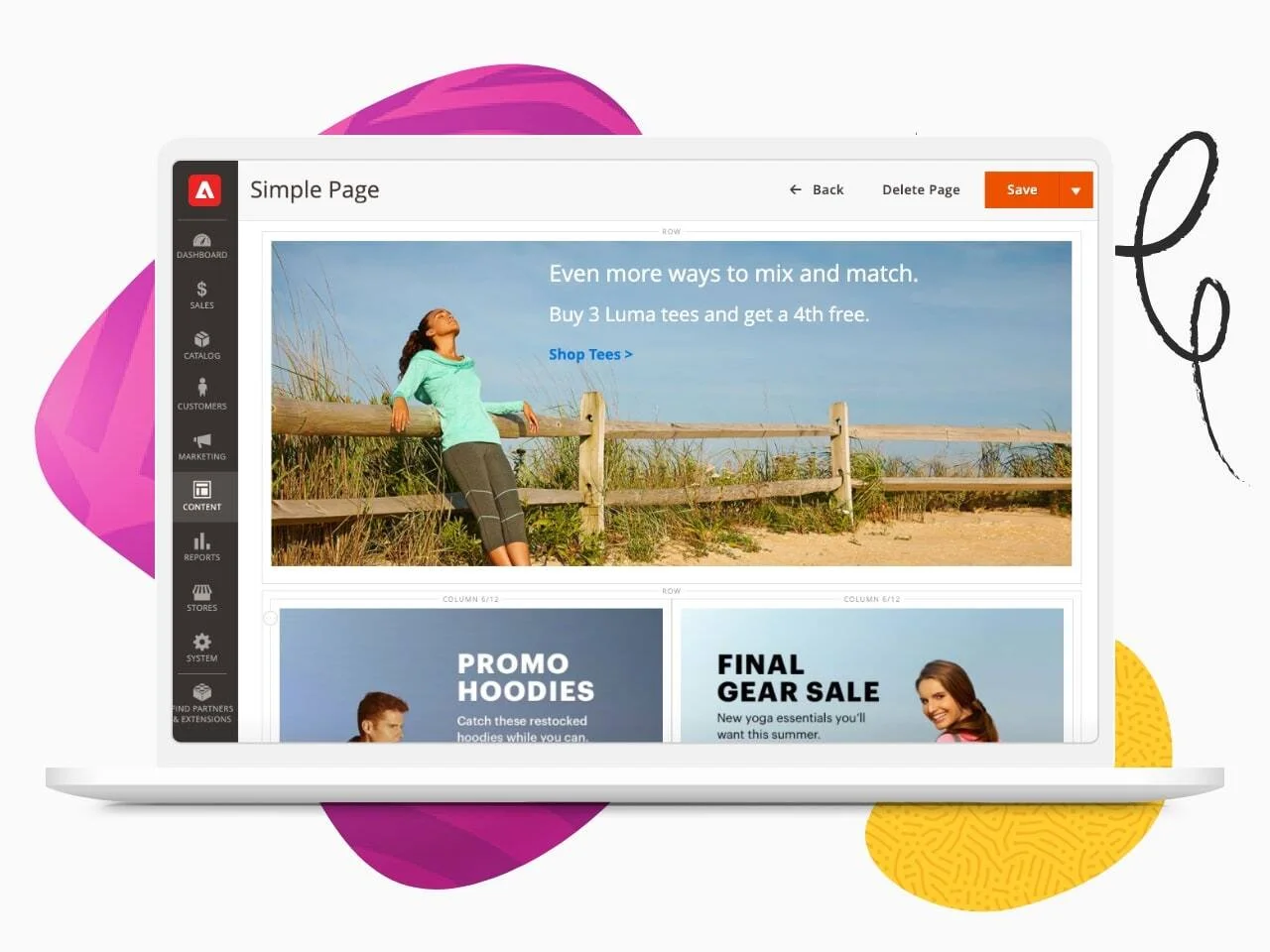
Large-scale stores need an enormous number of product variants with distinct colors, sizes, styles,… So, in terms of product variants, unlike Shopify Plus, Magento Commerce offers store owners unlimited variants to satisfy that kind of demand. However, you should not let the number of records exceed 2,500 per product.
The verdict
Though Magento Commerce has an advantage over Shopify Plus in terms of unlimited product variants, Shopify Plus still offers more robust built-in features & add-ons that support you in scaling your business.
Should you want the flexibility of managing your store, you can perform migration to Shopify Plus.
#4 Multi-store Management
Luckily, merchants are now able to create multiple stores on both Shopify Plus vs Magento Commerce.
Shopify Plus multi-store management
As a future store owner on Shopify Plus, you might be interested in the following features:
- Expansion stores: Shopify Plus multi-stores enable you to add 9 more storefronts for shoppers from various locations besides the main one. From a single dashboard, you can manage all your stores, analytics, employee accounts, user permissions, and automation tools. However, you need to notice that each additional store would be charged based on your GMV (Gross Merchandising Value).
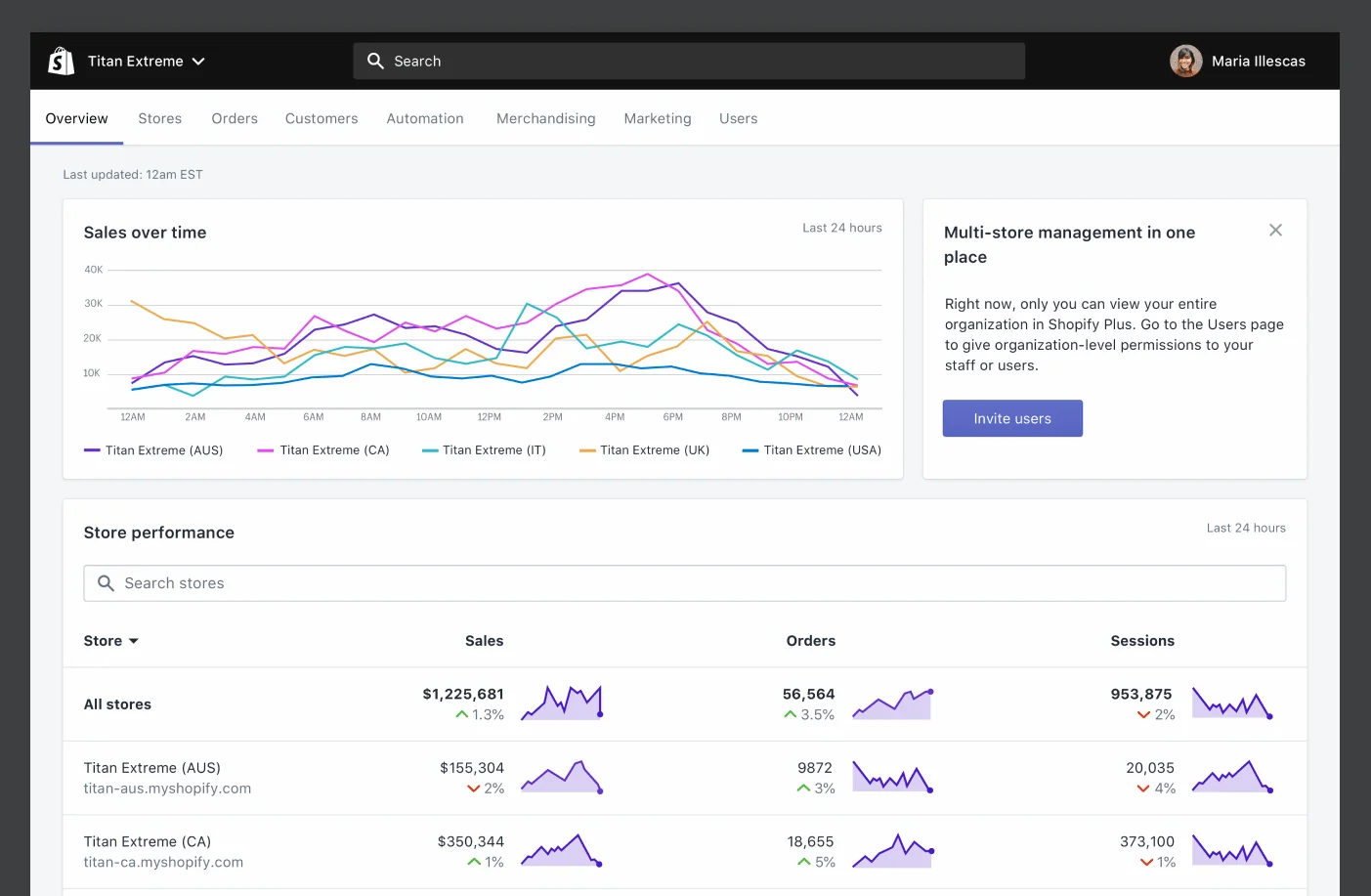
Shopify multi-store dashboard - Currency Converter: Only stores using Shopify Payment can use this feature. The conversion fee will be added to the last price and automatically converted based on the foreign exchange rate. Unfortunately, it means that you cannot set up different prices for a product in separate locations.
- Multi-warehouse: Shopify Plus allows you to set up many locations to track your inventory and fulfill your orders efficiently. You can only have 4 locations on the Basic Shopify plan, but the maximum number in Shopify Plus will be 20.
Magento Commerce multi-store features
Magento’s multi-store architecture seems to be superior to Shopify Plus. From just one interface, you can manage multi-brand, regional stores, and all B2C/B2B stores. In comparison with Shopify Plus, Magento Commerce supports the features below:
- Expansion store: Magento sets no limit to the number of additional stores you can create. It helps you build various websites for a unique brand or even multiple brands. Product catalogs can be shared across different websites, stores, and store views, and you can easily make changes at distinct levels. This feature is unavailable on Shopify Plus, although it is essential for store owners with large catalogs shared across many sites.
- Localized pricing: If your business is running globally, there are many reasons why you want to set different product prices in different locations. With Magento Adobe Commerce, you’re able to manage and edit advanced pricing for your products.
- Multi-source inventory (MSI): You can set up your own stocks, sources, salable quantity, performance, and partial shipment. Furthermore, Magento has its own Source Selection Algorithm to optimize the operation of your inventory.
The verdict:
In this competition between Shopify Plus vs Magento Commerce, Magento Commerce is the obvious winner. No matter how big your brand is, you can keep expanding without meeting any limitations. So, if you want to move to Magento Commerce, LitExtension is always here for you!
#5 Merchandising
Merchandising is “the activity of promoting the sale of goods,” and it plays a significant role in the success of an eCommerce business. In this part, let’s see the difference in merchandising between Shopify Plus vs Magento Commerce.
Shopify Plus merchandising
When it comes to Shopify Plus, the platform can also facilitate merchandising in some ways. Users can choose from base ordering options and also manually reorder products in their collections, which is better than a lot of platforms. You are also able to set a base order and then switch to manual and re-order from there, which satisfies a lot of users.
The options for base ordering are:
- Best selling
- Product Name A-Z and Z-A
- Price high-low and low-high
- Newest and oldest
You can then use the manual method as well, which allows users to drag and drop products in their chosen order, as below:
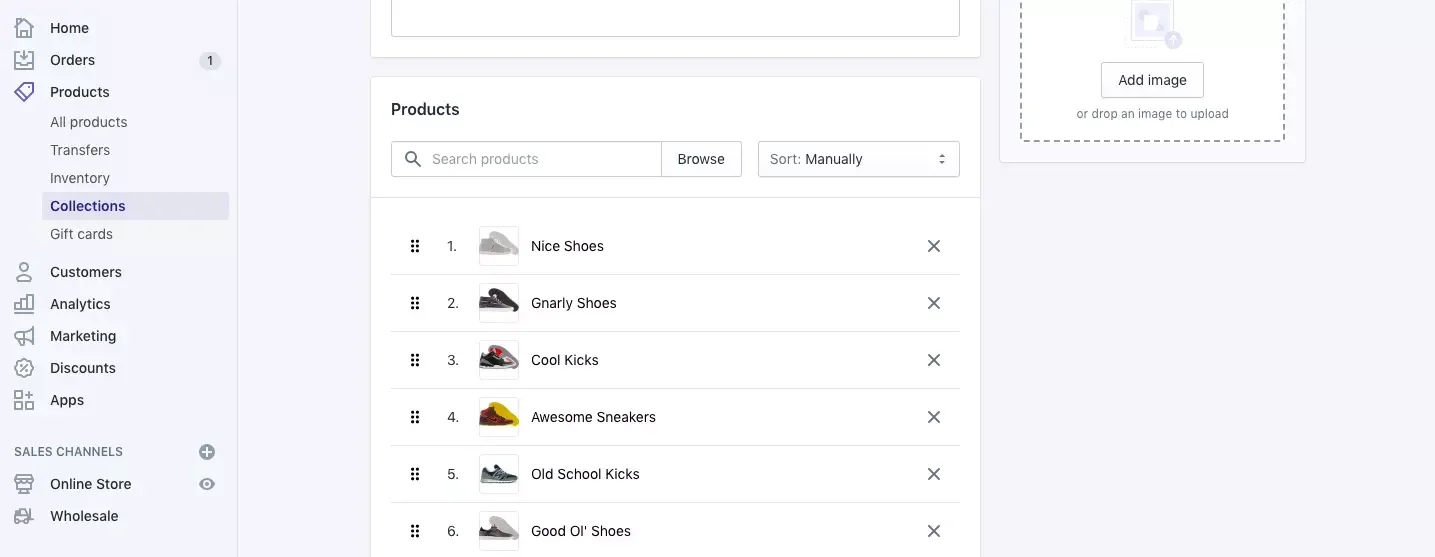
Because of its simplicity in managing a product category, Shopify Plus is the favorable choice for merchants with simple products, like fashion retailers.
However, Shopify Plus does not support multiple product types (but you can use variants for configurable items). If you are selling a digital product, you can still add them to your store normally. However, to enable your customers to download the products after they purchase them, you need to install a Shopify app named Digital Downloads. The app will link the attachment to a specific variant of your existing product in-store and send a download link via customers’ email.
Besides, you can sell a gift card in an online store like any other product because it is considered to be a special product type. You might also consider sharing links to gift card products on social media or issuing a gift card to a customer for free as a reward or incentive.
Magento Commerce merchandising
Natively, there are 7 standard product types on Magento Commerce:
- Simple products
- Configurable products
- Bundled products
- Downloadable products
- Virtual products
- Grouped products
- Gift cards
If your store is using Magento Commerce Edition, you can create rules to set up related products that you want to display. These rules reduce the manual work, especially for sellers with large categories (consisting of thousands of products). This is the unique selling point of Magento Commerce and a feature that lots of merchants are using.
Visual merchandising is also available on Magento Commerce. It is a set of advanced tools that allows you to position products and apply conditions that determine which products appear in the category listing. It also enables merchants to drag and drop or set position values to change the position of a product.
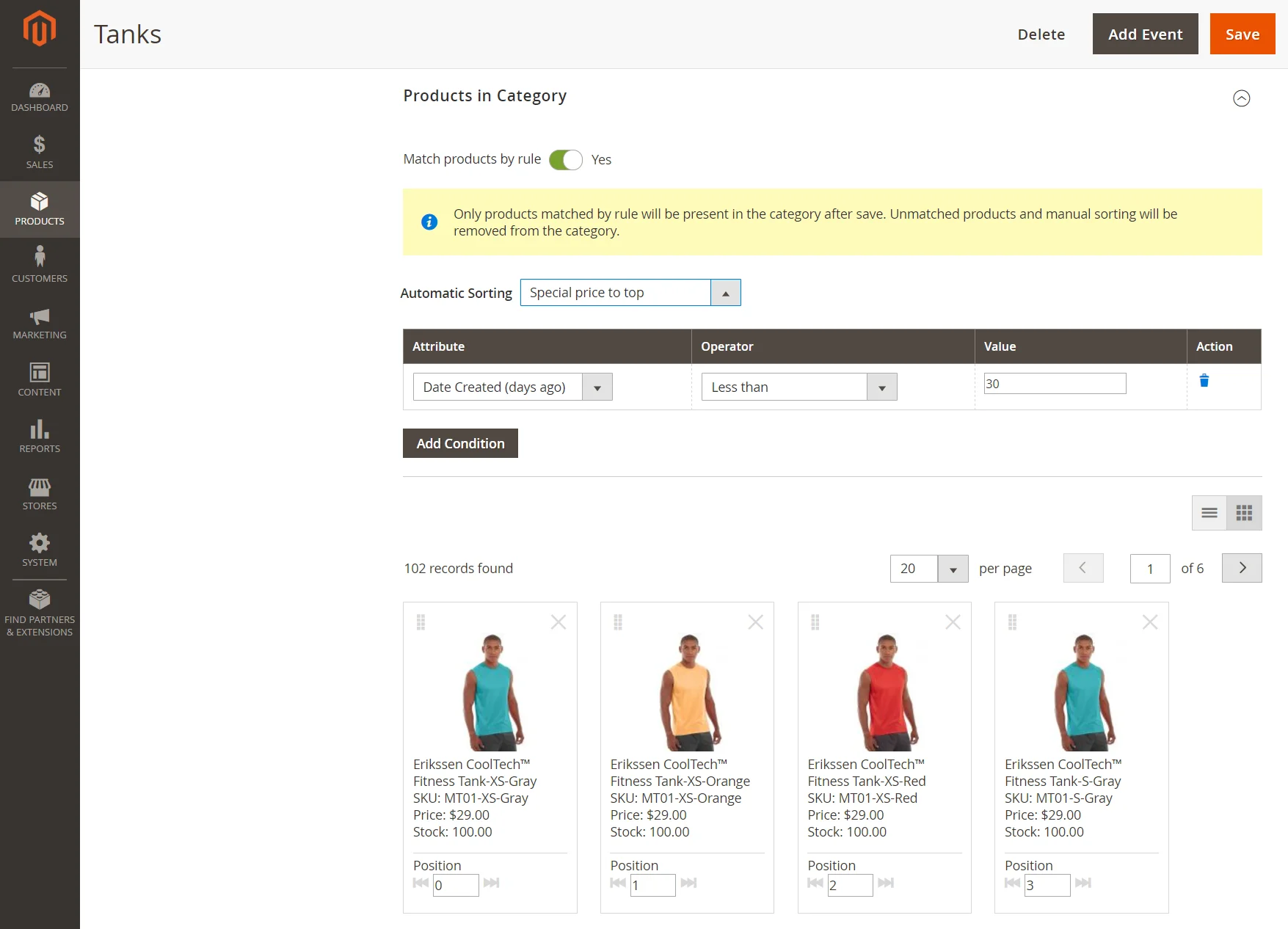
Alternatively, you can improve your merchandising performance by outsourcing to third-party apps and extensions. Magento Marketplace and Shopify App Store can provide you with tons of tools.
The verdict:
Without a doubt, Magento is much more flexible in this field and better suited to customized requirements.
Want to move to Magento Commerce? Here are 2 popular migration pairs:
#6 B2B Functionality
Both Shopify Plus vs Magento Commerce are made-to-measure for big enterprises. Thus, it’s a pity if we don’t mention B2B functionality in this side-by-side comparison.
Shopify Plus B2B
Shopify Plus has all the essential wholesale features you may need. From a single dashboard, you can:
- Set company profiles with unique payment terms and user permissions;
- Set price lists for a specific buyer;
- Assign net payment terms;
- Custom store theme with Shopify Liquid;
- Allow automated checkout for a seamless checkout experience;
- Let business customers manage their accounts.
In the wholesale section in the dashboard, you can set up a separate channel. Based on your existing shopping cart data (products, customers, orders…), you can configure your tiered pricing structure and discounts for specific customers.
The front-end template for wholesale is extremely basic, and everything is non-editable, except for your logo.
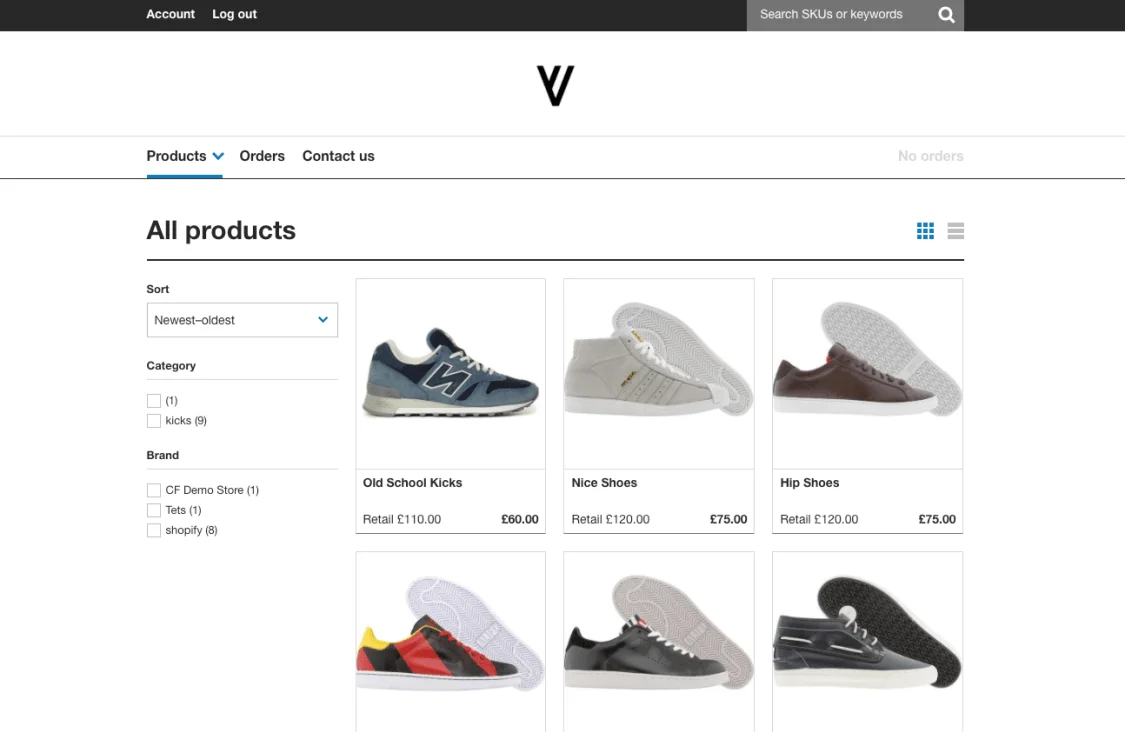
As you can see from the theme above, if you need to add other product details in the category page, such as star rating or numbers of orders, you have no way to customize the theme from scratch for different groups of tagged customers or build a completely separate store for wholesale.
Moreover, you also have to encounter issues with payment and shipping options. It is impossible for you to provide different payment methods (e.g. pay a certain percentage of the total cost as a deposit first, and make the full payment later), shipping options (e.g. a special shipping rate for customers or a same-day option) to different wholesale customers.
You might also be interested in reading:
Magento Commerce B2B
Magento Commerce B2B suite comes with a lot of strong features, such as:
- Manage quotes
- Create customer-specific catalogs
- Manage various settings against customers
- Assign roles to users
- Assign budgets to users and companies
- Setup credit limits
- Various approval workflows
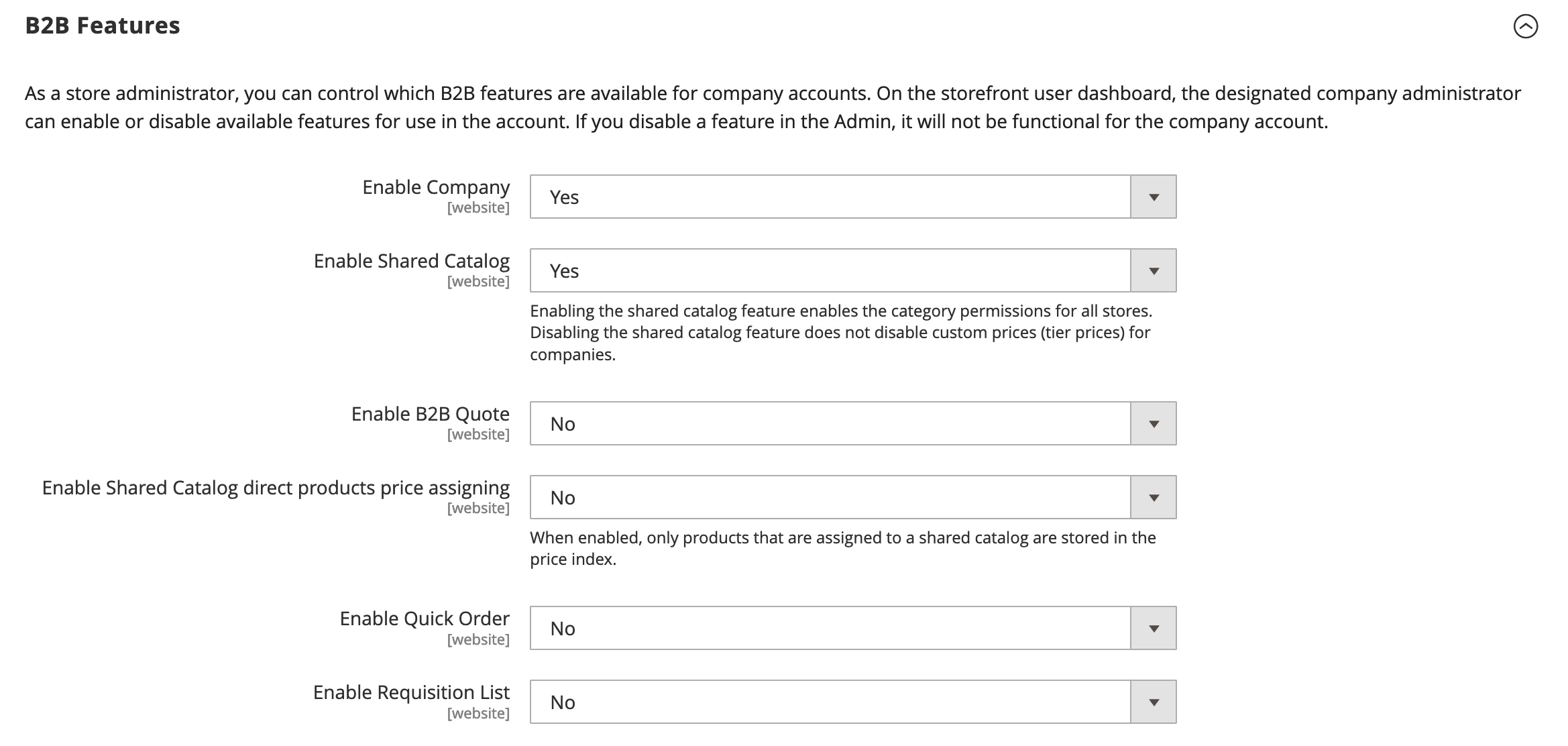
Even when you are using Magento Open Source, things like customer groups, tiered pricing, customer-based pricing and product availability, customer-specific promotions,… are all supported. These features are also available on Magento Commerce, and a wholesale store with those functions is even better than a store in Shopify Plus.
You can even turn your Magento store into a multi-vendor marketplace like Amazon, Alibaba, or Etsy… just with an extension.
The verdict:
Magento Commerce is a much more comprehensive solution for B2B businesses than Shopify Plus.
#7 SEO
SEO is a principal factor in your eCommerce business. Therefore, merchants would definitely prefer to choose an SEO-friendly platform from the start.
Shopify Plus SEO features
With Shopify Plus, all configurations are made at the server level. You cannot modify things like URL structure and hierarchy and caching headers, or implement certain technical SEO components easily.
Shopify Plus comes with a very basic set of SEO options. You can only edit meta tags and optimize both your inventory and your product pages. In addition, building a Shopify Plus store on a sub-directory is impossible.
However, you can improve your Shopify Plus SEO performance through the help of Shopify SEO apps. To make it easier when selecting the most suitable one for your website, LitExtension has made a collection of the best Shopify SEO apps to resolve the consideration.
Magento Commerce SEO features
In contrast, thanks to Magento Commerce’s open-source system, it is more flexible to improve SEO performance on this platform. Additional features like no-follow links, redirect links, and canonical tags make it easier for search engines like Google and Bing to index your website.
Another big strength of Magento Commerce over Shopify Plus is that your store does not need to be on a local ccTLD (country code top-level domain) or a subdomain. You can absolutely build it on a sub-directory. With sub-directories, your site could get crawled more often as you are constantly adding new content. The SEO authority that you have will be inherited by your primary site.
The verdict:
Magento Adobe Commerce is actually stronger on SEO, and you will not need to make substantial changes.
#8 Support & Help
Moving to the next part of Shopify Plus vs Magento Commerce’s head-to-head comparison, let’s take a look at their customer support.
Shopify Plus support
Shopify Plus support system can save you a considerable amount of cash that you need to pay for development.
You are able to get access to a dedicated merchant success manager. Shopify Plus experts would be available 24/7 to help you grow your business and handle all your issues without any additional fee. You are free to request support for technical problems, marketing, or conversion rate optimization. Support is accessible via different channels like phone, email, or live chat.
Magento Commerce support
Meanwhile, for Magento Commerce clients, it is purely developer support. Magento Commerce Consulting Group (ECG) can also give you a hand, but it requires an extra fee.
Hence, you need to review your actual business demand before paying for anything. All in all, both Shopify Plus vs Magento Commerce offer dedicated support that would solve your problems as quickly as possible.
The verdict:
In this comparison between Adobe Commerce vs Shopify Plus, Shopify Plus has an edge in terms of support.
Want to migrate to Shopify Plus?
If you intend to migrate to Shopify Plus, LitExtension offers a great migration service that helps you transfer your data from the current eCommerce platform to a new one accurately and painlessly with utmost security.
Shopify Plus vs Magento Commerce – FAQs
[sp_easyaccordion id=”47055″]
Shopify Plus vs Magento Commerce: Which One is Right for Your Business?
Overall, Shopify Plus is more suitable for stores that are quickly growing and require less complex, customized, and integrated solutions. It is especially the best option if your website is already on Shopify.
For those of you looking to build websites on a large, international scale and are close to generating $5 million in revenue per year, Magento Commerce (Adobe Commerce) would offer you more flexibility.
You may want to consider: do you need flexibility or simplicity for your business? Obviously, the more flexible and customizable a platform is, the more complex it is.
Are you planning to migrate your store?
After careful consideration, you may have already made your own choice for your business. If you are planning to migrate from Shopify Plus to Magento Commerce or vice versa, LitExtension is there for you.
With our help, switching to another platform is no longer a big deal. We offer an advanced automated migration service that transfers all your data to another platform quickly, with a high level of security and accuracy.
To have your doubt cleared in the blink of an eye, we provide a free Demo Migration feature for you to check on yourself how the process works. Should you have any questions, please contact LitExtension Team. You can also check out LitExtension blog and join our Facebook Community to get more eCommerce tips and news.